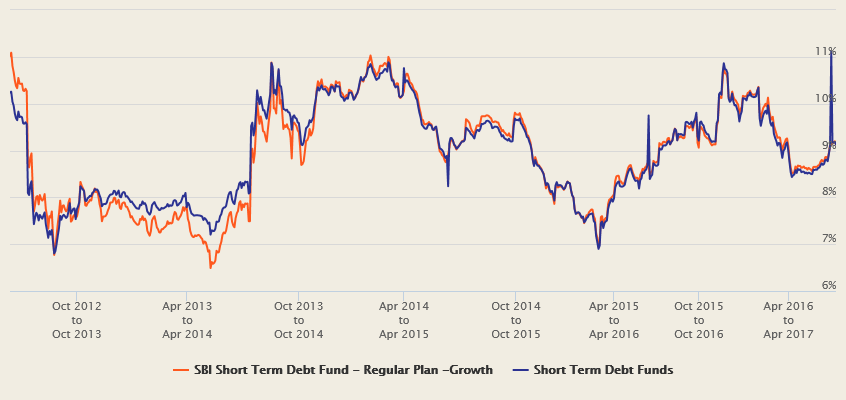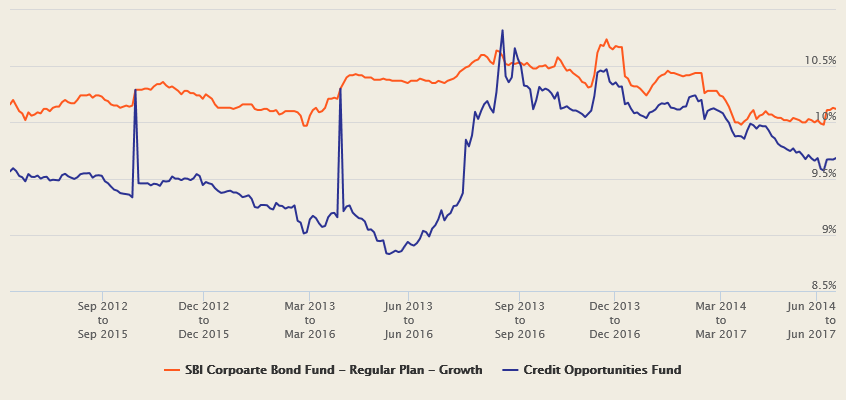What are short term investment options with bank FD rates at lowest point in many years

Bank Fixed Deposit (FD) interest rates are at their lowest point in many years. As per moneycontrol.com data, less than 1 year FD interest rates of major public sector banks are around 6.5% only. For private sector banks, less than 1 year FD interest rates range between 6.5 to 6.75%. For 1 to 2 year term deposits, major public sector banks are offering around 6.9% interest rates while private sector banks are offering 6.9 to 7.15% interest rates. Jogging my memory, the last time term deposit rates were this low, was in 2009, that too, only for a few months (after RBI cut rates in the wake of 2008 financial crisis) before going up again. Prior to 2009, the rates were at the current (2017) level, way back in 2005 – 2006.
While low term deposit rates are certainly challenging for households who depend on FD interest income, declining FD rates should not have come as surprise for regular readers of Advisorkhoj blog. We have been saying for nearly six months or so, that FD rates were going to go down because banks are awash with liquidity post demonetization, the fiscal deficit is within control and because of the Finance Ministry’s desire to see lower interest rate to kick-start revival of credit off-take and economic growth. The RBI lowered its inflation projection in its last monetary policy update and the policy tone was quite dovish. The May 2017 CPI inflation number is a record low, which signals even lower rates in the future.
We, in Advisorkhoj, do not see ourselves as economic or political commentators. Our objective is not to critique policies, good or bad; rather we see our objective as empowering investors with knowledge and understand what the economic situation is, how it is likely to pan out in the future and how they can make financial decisions that are in their best interests. In this blog post, we will discuss alternative short term investment options in an environment of declining interest rates.
Risk Free Mindset
Many retail investors in India have a risk-free mindset towards fixed income investments. While some of these investors take risks in equity investing, they want risk free assured returns from fixed income investments. The lure of high assured returns caused many an investor to become victims of Ponzi Schemes and a number of families lost their lifetime savings in such schemes.
You should very clearly understand that, risk free return is the lowest possible return. If any FD scheme, unless it is issued by an RBI regulated commercial bank or highly rated (FAAA or FAA) by the leading credit rating agencies (e.g. CRISIL , ICRA etc.), is assuring you risk free returns which are higher than lowest possible return, then the issuer is very likely planning to defraud you. If you want risk free assured returns, be prepared for the lowest interest rate possible. However, the risk free return on a post-tax basis often is lower than effective rate of inflation applicable for a typical urban / semi urban consumption basket.
If the return on investment (on post-tax basis) is lower than the inflation rate, then the real rate of return is negative. If the real rate of return is negative, it implies that, you are better off by consuming rather than saving, because your money today will be worth more than what your savings (with interest) will be in the future. It is, therefore, natural that, you may want higher than risk free returns. Your bank FD returns are the risk free returns over the FD term. If you want higher returns than your FD interest rate, then you will have to take some risk. Mutual funds invest in capital market securities, which have higher risks than risk free instruments, but they are, for the very same reason able to provide higher returns than risk free instruments. Investors should understand that, risk and return are directly correlated. However, many investors have a flawed understanding of risk of debt mutual funds.
Mutual funds have higher risks but also give higher returns
Many investors usually associate mutual funds with stock markets and since stock markets are risky, as such, investors have the perception that, mutual funds are risky. Investors should understand that, mutual funds invest in market linked assets and prices of such assets are determined by market forces. So while all mutual funds (debt or equity) are subject to market risks, investors should understand that risk of different asset types (equity versus debt) and different capital market segments (equity market versus debt market) are vastly different. Let us understand next, in greater details, difference between price volatility (commonly perceived as risk) and actual risk of debt securities.
What is risk in capital market fixed income securities?
Risk, in our view, is the danger of you losing a part or all of your capital. Here, we should distinguish between a notional loss and actual loss. If you invest in a market linked product, your investment value will fluctuate on a day to day basis, depending on the value of the underlying securities in the capital markets. However, this is day to day fluctuation; in our view is volatility and not loss. Loss is a permanent reduction in capital, whereas volatility is temporary fluctuation, which may or may not result in permanent reduction. This is a very important distinction, especially in fixed income (or debt) investing.
Let us understand this with the help on an example.
Let us assume that, you have invested Rs 1 lakh in a bond whose face value is Rs 100 and a coupon of 8% (due in 6 months), maturing in 2 years. Let us suppose, you paid Rs 101 to buy the bond. You will purchase 990.1 bond units. Let us suppose, yields (interest rates) go up after you buy the bond (bond prices fall when interest rates go up and vice versa) and the price of the bond after one month is Rs 98. The book value of your investment will be Rs 97,030. So notionally, you have made a loss of Rs 2,970. After 6 months, you get a coupon (interest) payment of Rs 7,920 (8% of Rs 100 times the number of bond units, 990). Next year, you will again get a coupon payment of Rs 7,920. When the bond matures after two years from purchase, you will get the face value. The maturity amount for you will be Rs 99,010; add to it the coupon (interest payment) and the total money you get from your investment will be Rs 106,929.
So overall, you made a profit of Rs 14,850 on your Rs 1 lakh investment, though at one point of time, you were making a loss of Rs 2,970. Even though, you were making a loss of Rs 2,970 one month after investing, by holding the bond to maturity, you made a profit of Rs 14,850 irrespective of the price fluctuations in between. The price of the bond may have even gone down to Rs 95 from your purchase price of Rs 100, but price fluctuations will not matter, if you hold the bond to maturity. This is the essence of bond investing.
Let us now discuss about, different type of mutual funds that are suitable for short term investing. We should clarify further that, by short term investing, we mean investment horizons of less than 2 to 3 years. As far as short term investments are concerned, four categories of mutual fund products are suitable, depending on different investment tenures and risk appetites. We will explain risk return characteristics of these product categories with the help of references to top performing mutual fund schemes from SBI Mutual Fund stable.
Short Term Debt Funds:
Short term bond funds invest in Commercial Papers (CP), Certificate of Deposits (CD) and short maturity bonds. The average maturities of the securities in the portfolio of short term bond funds are in the range of 2 – 3 years. The fund managers employ a predominantly accrual (hold to maturity) strategy for these funds; therefore, interest rate risk is very minimal. Short term debt funds are suitable for 1 to 3 year investment tenures. SBI Short Term Debt Fund has given 9.1% and 8.9% annualized returns over the last 1 to 3 years respectively. The chart below shows the 1 year rolling returns of SBI Short Term Debt Fund over the last 5 years.

Source: Advisorkhoj Rolling Returns Calculator
The average 1 year rolling return of this fund over the last 5 years was 8.9%. The maximum 1 year rolling return was 11% while the minimum was 6.5%. The scheme gave more than 8% annualized rolling returns around 67% of times.
Credit Opportunities Funds:
Credit opportunities fund are similar to short term debt funds. The fund managers lock in a few percentage points of additional yield by investing in slightly lower rated corporate bonds. Despite the slightly lower credit rating of the bonds in the credit opportunities fund portfolio, credit risk should not be a concern for the investor because the funds invest in papers rated A and higher.The fund managers hold the bonds to maturity and so there is very little interest rate risk. Good credit opportunities funds have excellent returns in the recent past. However, investors should be comfortable with credit risks before investing.Credit opportunities funds are suitable for 2 to 3 year investment tenures. SBI Corporate Bond Fund has given 10% annualized returns over the last 1 to 3 years respectively. The chart below shows the rolling returns of 1 year SBI Corporate Bond Fund.

Source: Advisorkhoj Rolling Returns Calculator
The average 1 year rolling return of this fund over the last 5 years was 10.3%. The maximum 1 year rolling return was 11% while the minimum was almost 10%. The scheme gave more than double digit returns almost all the time, for one year investment tenures over the last 5 years. It is truly outstanding performance. The performance of SBI Corporate Bond Fund is by itself, an excellent counter argument to the flawed risk return perceptions that many investors have with regards to debt funds. We urge our readers to empower themselves with knowledge, rather than being led by perceptions.
Conclusion of this part
In the first part of this blog post, we have discussed that, even though term deposit rates are declining, there are a variety of mutual fund investment options that, can meet a wide spectrum of investor’s risk return needs. We have discussed how short term debt funds and credit opportunities score over fixed income investments by giving higher return. Investors need to broaden their horizons and empower themselves with knowledge of debt fund investments. In the next post we will discuss how ultra short term debt funds and liquid funds can fulfil your short term investment needs while giving higher returns. Please read the second part
Disclaimer:
Any information contained in this article is only for informational purpose and does not constitute advice or offer to sell/purchase units of the schemes of SBI Mutual Fund. Information and content developed in this article has been provided by Advisorkhoj.com and is to be read from an investment awareness and education perspective only. SBI Mutual Fund’s participation in this article is as an advertiser only and the views / content expressed herein do not constitute the opinions of SBI Mutual Fund or recommendation of any course of action to be followed by the reader
Mutual Fund Investments are subject to market risk, read all scheme related documents carefully.
RECOMMENDED READS
- Demystifying debt mutual funds
- Why Balanced Funds may be the best investments for new mutual fund investors
- How do you know if you have good funds in your mutual funds portfolio: part 1
- Know your mutual fund tax obligations to manage your investments effectively
- Asset Allocation is much more important than fund selection
LATEST ARTICLES
- SBI Dynamic Asset Allocation Active FOF: A smart asset allocation solution in shifting markets
- Your perfect Gift for your little ones this Childrens Day: SBI Magnum Childrens Benefit Fund Investment Plan One of the best performing funds for your childs future
- Magnum Hybrid Long Short Fund: A smart investment option in challenging conditions
- Delivering Returns with Resilience: SBI Multicap Funds proven multicap strategy
- SBI Equity Hybrid Fund: One of the top performing hybrid funds in current market conditions
Quick Links
Follow SBI MF
More About SBI MF
POST A QUERY





